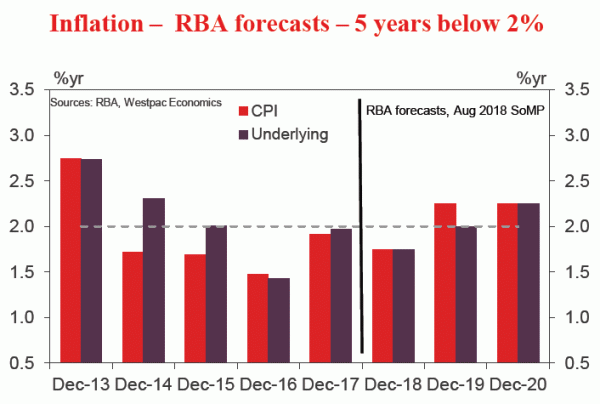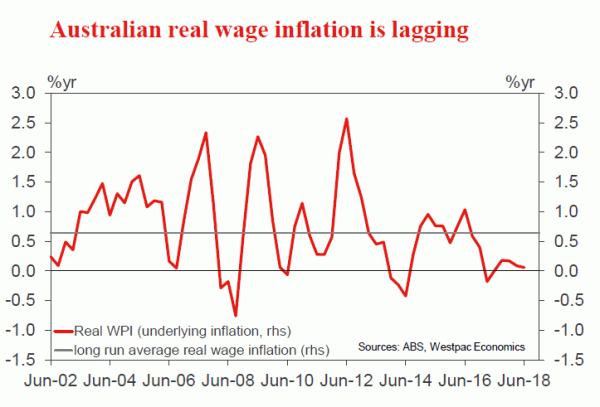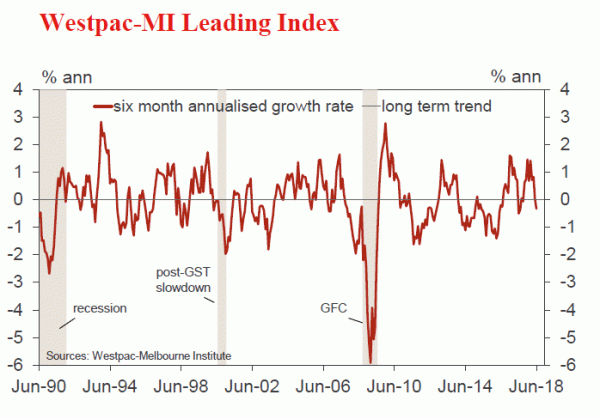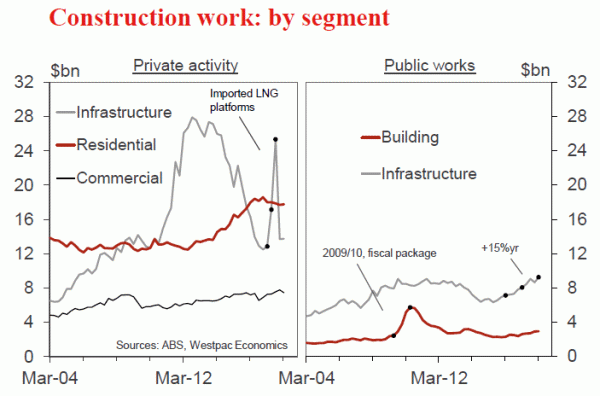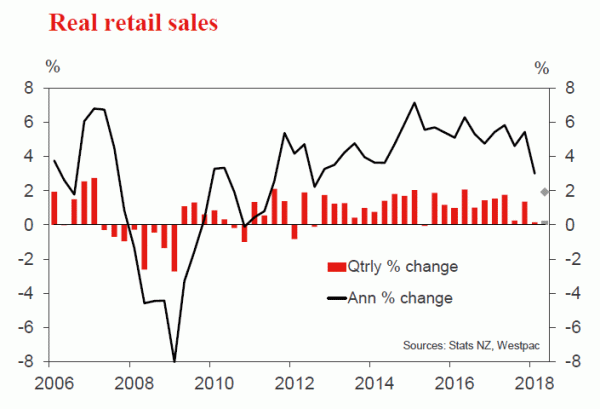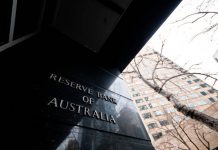Week beginning 20 August 2018
- Inflation expectations might be anchored despite the official 2.5% target.
- RBA: Minutes, Governor Lowe and Deputy Governor Debelle speak.
- Australia: Westpac-MI Leading Index, construction work.
- NZ: real retail sales.
- US: Fed Chair Powell speaks at the Jackson Hole Symposium, durable goods orders.
- Flash Markit PMI’s for Japan, the Euro Area and the US.
- US-China trade discussion and scheduled implementation of 2nd round tariffs.
- Key economic & financial forecasts.
Information contained in this report current as at 17 August 2018.
Inflation Expectations Might be Anchored Despite the Official 2.5% Policy Target
Last week the Reserve Bank surprised by lowering its inflation forecasts for 2018 (both underlying and headline).
Headline was lowered from 2.25% to 1.75% and underlying was lowered from 2% to 1.75%.
If correct, that means underlying inflation will have printed below the bottom of the 2-3% target range for three calendar years in a row. Headline inflation will have printed below the bottom of the 2-3% target for five calendar years in a row.
Economists and policy makers generally focus on underlying inflation when assessing the meaning of the “signal” from any inflation print. That is appropriate because the underlying measure “trims out” any large “one off” movements that might be misinterpreted.
However, when assessing inflation over the long term the headline measure is important since it should be a more reliable driver of inflationary expectations.
After all, expectations could be reasonably expected to be influenced by what has actually happened rather than a statistical interpretation of the data.
Inflationary expectations are critical from a theoretical perspective to delivering an inflation outcome. They impact workers’ wage demands and firms’ pricing decisions.
“Inflationary expectations” are like “the natural rate of unemployment” or “the neutral policy interest rate”. They are highly attractive concepts for economists. However they are notoriously difficult to measure.
Consider the “natural rate of unemployment”. For Australia that measure is generally accepted to be 5%. As such it is expected that any unemployment rate below 5% will be associated with rising wage pressures. However evidence from other countries indicates that in this period of accelerating technological development, which is often “job substituting”, natural rates are lower. We expect that it is highly likely that the natural unemployment rate will also be lower in Australia. But we will not know for sure until we get there. Certainly the Federal Reserve had a view that the rate was around 4.75%. But as the rate fell through 4.75%, wage pressures were missing.
We are not sure what the position of the Reserve Bank is on this issue given that the unemployment forecasts envisage the unemployment rate holding above 5% until near the end of 2020 and yet wage pressures are expected to build through the forecast period.
Policy makers forecasts and market watchers try to measure inflationary expectations. The Reserve Bank uses a range of measures – market economists’ forecasts; unions’s forecasts; inflation swaps; and the 10 year inflation indexed bond. These measures have been gradually falling and are described by the Bank as “generally consistent with the inflation target”.
However, the inflation target has been fixed for twenty years yet the expectations which used to be well above the target are now around the target. One exception is the measure which is widely used by other central banks, including the FED, the 10 year inflation indexed bond. Implied inflation expectations have steadily fallen from 3% to 2% over the last 10 years – well below the 2.5% target.
This comfort that inflationary expectations appear to be settling around the inflation target is the key reason why the Bank resists the periodic calls to lower the target.
The Bank believes that the existence of the target is a dominant driver of inflationary expectations. Consequently, if the target were to be lowered, then expectations would fall and a more disinflationary environment would evolve. This puts considerable weight on the target as a driver of expectations.
But, as discussed, the Bank has been unable to even reach the bottom of the target zone for five calendar years. Furthermore, they have made it quite clear that the next move in rates is up. Reasonably, economic agents could conclude that, even after five years, there is no urgency to reach the target.
We are unable to find a definitive measure of inflationary expectations. However after five years of underperformance of headline inflation below 2%, economic agents would be excused if they expected such conditions to persist.
With the Bank not prepared to use its interest rate “weapon”, and other policies around credit supply actually constraining activity, there must be a risk that, at least from an expectations perspective, low inflation is embedded in the system for longer than the Bank and the market is currently expecting.
In fact, Governor Lowe has often responded to demands to lower the target by claiming that others favour a higher target in order to boost inflationary expectations.
A reasonable query on the purity of the target could be made around the need to monitor financial stability when setting policy. That approach was confirmed by the Governor’s comments in a panel discussion at the Sintra Conference in June.
“To try to get it back to 2.5% very quickly, it would be mainly through people borrowing more money, and having higher asset prices — I think that’s a much bigger risk to our economy than people having surprisingly low inflation expectations.”
Reasonably, we can conclude that after five years of missing the bottom of the target zone, a more aggressive pursuit of the inflation target has been constrained by the need to address Australia’s challenges around financial stability.
The Bank is currently forecasting that despite three years of above trend growth (3.25% in 2018; 3.25% in 2019; and 3% in 2020 against a trend growth rate of 2.75%) inflation (headline and underlying) will only have lifted to 2.25% by 2020.
Perhaps that looks cautious but with inflationary expectations potentially anchored at or below 2%, it might be a tough target to achieve unless the Bank was willing to signal that it was prepared to pursue its target more aggressively.
The week that was
For Australia, the past seven days have been focused on the labour market, with updates for wage growth and employment received.
On employment, the 4k decline in jobs in the month of July was well below the market’s expectation, but in line with our own. Given it follows an outsized 58k gain in June, the weak July outcome is certainly not a cause for concern. Indeed the past three months have seen an average monthly gain of 22k, ahead of the 18k trend pace of growth. Looking ahead, we anticipate that momentum in employment will slow in the second half of 2018.
Based on employment growth, wages growth should be much stronger than the 2.1% reported for the year to June 2018. Here we see the impact of the underutilisation of workers which, in our view, is set to remain a significant concern hence. Broadly we believe this under-reported slack will hold nominal wage inflation around 2.0% through the remainder of 2018 and 2019 and, as a consequence, real wage growth will be negligible. This situation will continue to weigh on households’ perceptions of their family finances and willingness to spend.
Another important consequence of inflation persistently at the lower-bound of the RBA’s target range and weak (or no) real wage growth is that household’s inflation expectations are suppressed.
Outturns as above would be a stark contrast to the positive expectations of the Government and the RBA – the latter re-iterated during Governor Lowe’s appearance before the House of Representative’s Standing Committee on Economics this week. This is why we believe aggregate growth in 2019 will be sub-trend, and that the RBA will remain on hold into 2020.
Turning to the US, the New York Federal Reserve’s consumer credit survey was the highlight, but out of the headlines. Conflict between the US and Turkey instead remained front of mind for the press. This is a highly uncertain situation, and is unlikely to be resolved soon. We are not overly concerned by the effect this situation will have on global trade or growth, but we are mindful of potential spill-over effects to the European banking sector (who have considerable exposure to Turkish corporates) and to sentiment towards other emerging markets. Developing nations geographically near Australia are in a far better situation than Turkey and where they were in the late- 1990’s (based on current account and external debt metrics). Hence a real economy and/or emerging market financial market contagion in our region is highly unlikely. Still, amid uncertainty, market participants are likely to sit on the sidelines until the data confirms there is no need for concern.
As we continue to outline, the greater risk to the region is likely that emanating from China’s domestic banking system as it undergoes lasting change to rein-in shadow banking activity and shift the majority of credit supply to the banks. Chinese credit data is now available to July. In the most recent release, a further fall in shadow banking credit was seen such that credit provided by these shadow lenders has now only increased by about RMB700bn in 2018 compared to almost RMB3.5trn at this time in 2017. Greater lending by the banking system has only offset around RMB900bn of the reduction in new shadow credit in 2018, so total credit growth in 2018 is almost RMB2trn less than the prior year. This outcome is intended and well managed, but whenever a policy shift of this magnitude is undertaken, there are risks which must be monitored. It is not happenstance that Chinese regulators have recently acted to ease financial conditions and bolster market liquidity.
In these uncertain times, a clear positive for China’s economy is their housing market. In stark contrast to the 5.5% gain for total fixed asset investment, real estate investment is running at a 10% year-to-date pace. Further, the recent acceleration in starts implies that the majority of this momentum will be sustained into year end, particularly as continued robust price growth in tier 2 and 3 make for an attractive sales environment. If gains for this sector are to endure, then both central and local authorities will need to push ahead with their intended long-term reforms to drive growth in industry and incomes across the nation. As we look ahead to next week, US/China trade relations will again fill the headlines, given a Chinese trade delegation is reportedly heading to the US for talks just before the US’ next round of tariffs are to take effect.
Chart of the week: Australia wage inflation
Total hourly wages ex bonuses increased 0.6%, 2.1%yr in Q2. Wage growth remains weak and remarkably so across industries, sectors and states. At a national level, the only real sign of any lift in wages was in the public sector, particularly in Victoria, with a focus mostly in health services. But even here the heat appears to be limited and the pace of growth has peaked.
Is low inflation behind low wages? Not really, real wages growth is just 0.1%yr as at Q2. Real wages are best described as being flat for more than a year now.
Will the recent repeat of an outsized increase in the minimum wage for 2017/2018 boost wages in the September quarter? Given that the increase is on par with the increase in 2016/17, it should hold rather than increase momentum. However, as we saw little pass through from the last increase, will the pressure be greater on firms to pass on more this time? We shall have to wait to find out.
New Zealand: week ahead & data wrap
Low for longer
After digesting last week’s Monetary Policy Statement from the Reserve Bank, we have concluded that the OCR will now remain on hold for longer than we had previously assumed. That’s not to say we’ve been surprised by unexpected weakness in the economy. On the contrary, the economic slowdown currently in train is something we have consistently warned about over the past year. Rather, it’s the view of the RBNZ, under new Governor Adrian Orr, that has evolved. This shift in the outlook for interest rates will filter through to other aspects of our economic forecasts. Most notably the housing market and the exchange rate.
This week we changed our view on when we think the RBNZ is most likely to raise rates. Previously we had the first rate hike pencilled in for November 2019. We now think the OCR will remain on hold until May 2020, rising slowly thereafter.
What’s more, there’s a decent chance that the RBNZ will cut rates in the next twelve months (we put the odds at one in three).
Importantly, this change in view has little to do with the state of the economy. We have long warned of a slowdown in growth in 2018 and predicted that the RBNZ would become more dovish as it’s more upbeat view converged with our own more pessimistic outlook. Indeed that is broadly what’s happened (though, as is often the case, the RBNZ lurched even further than we expected last week).
Instead, the main reason for our change in call is the RBNZ’s shift with the new Governor at the helm. Recent RBNZ communications have consistently surprised on the dovish side of the spectrum, with the biggest shift in last week’s Monetary Policy Statement. A move that was bigger than can be explained by data surprises alone. We strongly suspect that the new regime will be keener to shore up GDP growth when it flags, and more willing to take a risk when inflation is rising. Essentially the Reserve Bank has become more dovish.
Given this backdrop, the key question is whether or not the Reserve Bank will go so far as to cut the OCR, having already warned it is “near the trigger point”. While we think such a move is possible, it would require the data to disappoint relative to the RBNZ’s expectations. And our view is that this is unlikely. In particular, June quarter GDP will probably print closer to 1% than the 0.5% the RBNZ is forecasting, and we think September quarter inflation will be 1.7% in contrast to the RBNZ’s 1.4% pick. What’s more, the surprisingly dovish Statement from the RBNZ has seen the NZ dollar plunge and it now sits well below the RBNZ’s forecast.
These data surprises are likely to coincide with signs of more broad-based improvements in the economy. The Government’s Families Package has boosted the incomes of some households and is expected to support spending in the coming months, Government consumption is ramping up and the falling exchange rate will boost the incomes of exporters. Consequently, GDP growth in 2019 is likely to temporarily accelerate to 3.1%.
The expectation of lower interest rates will filter through other aspects of our economic forecasts. The New Zealand dollar has fallen sharply to just under 66 cents against the US dollar and momentum is still downward at present. However, later this quarter we expect a rash of positive data to arrest this decline or even cause a temporary pop higher. Over a longer horizon, we retain our view that the NZD/USD will depreciate further. We expect the NZD/USD to fall to 64 cents by September this year, lingering at these levels for a time before gradually moving higher as interest rate differentials once again start moving in favour of a firmer NZD/USD.
Lower interest rates will also impact the housing market, where they will provide something of a counterbalance to the swathe of Government policies aimed at cooling investor activity.
This week’s REINZ data suggested the trend in the housing market remains fairly subdued. It showed July was a solid month for house prices (which were up 0.5% in the month) but a very weak month for sales, which fell almost 6%. The housing market in Auckland remains much weaker than other regions.
But the market reaction to last week’s Monetary Policy Statement has seen wholesale interest rates drop significantly. We estimate this will lead to a 0.2% drop in two year fixed mortgage rates over the next couple of months. And with mortgage rates a crucial determinant of housing market developments, lower mortgage rates should give the housing market temporary a leg up in early 2019. We also expect the Reserve Bank to ease loan-to-value restrictions in the November Financial Stability Review, with the change to come into effect in January.
While these will be important positive developments, we retain our negative outlook on house prices over the longer term. The foreign buyer ban was passed by Parliament this week and will shortly come into effect. Although this is a watered down version of the original bill (with foreigners still allowed to buy new apartments in large developments and multi-storey blocks), we still expect it to have a significant impact on the housing market – particularly in Auckland and Queenstown where most foreign purchases take place. And the Tax Working Group is due to issue an interim report next month, which should give some indication of where capital gains or other property taxes sit on the Government’s agenda. In addition, interest rates won’t remain this low forever. Eventually rising mortgage rates will hit the housing market. We’re forecasting a house price decline of almost 3% for 2020.
Data Previews
Aus Jul Westpac-MI Leading Index
- Aug 22, Last: -0.33%
The Leading Index has been pointing to a clear slowing in momentum since the start of the year. The six month annualised growth rate came in at -0.33% in June, the first negative since September last year, pointing to a below trend growth pace well below the comfortably above trend reads seen late last year.
The July reading looks likely to be a little more positive. It will include several components with more positive updates, in particular, dwelling approvals which rose 6.4% vs -2.5% last month; and total hours worked which will incorporate two positive monthly updates since the last leading index release (+0.7% in June and +0.2% in July vs -1.3% in May). Other components have been more mixed: the ASX200, up 1.4% vs 3% last month; but consumer sentiment components softer and the remaining components – US industrial production, AUD commodity prices, and the yield spread unchanged.
Aus Q2 construction work
- Aug 22, Last: 0.2%, WBC f/c: 0.8%
- Mkt f/c: 0.8%, Range: -0.3% to 2.9%
Construction work consolidated in the March quarter, edging 0.2% higher to be 5% above the level of a year ago. Strength in public works in the quarter outweighed a surprise dip in private non-residential building activity.
For the June quarter, we anticipate a modest gain of 0.8%.
The strong upswing in public construction likely extended into the June quarter, with considerable further upside. We expect non-residential building work to rebound, consistent with approvals and the sizeable work pipeline.
Home building activity is expected to be relatively flat, as work in the sector crests at a high level ahead of a downturn in 2019. An uncertainty is private infrastructure work, we’ve factored in a modest fall as work on the gas projects is completed offsetting a lift in non-mining projects, centred on power generation (particularly renewables).
NZ Q2 real retail sales
- Aug 22, Last: +0.1%, Westpac f/c: +0.2%
After adjusting for price changes, retail spending was essentially flat over the March quarter. Much of the weakness in spending was concentrated on fuel and vehicle spending (dampened respectively by rising petrol prices and delays with vehicle importation). Spending in core categories rose by 0.6% over the quarter.
We expect that overall retail spending will rise by 0.2% in the June quarter, including a 0.3% rise in the core categories. This modest pace of growth is consistent with the cooling in the housing market that is weighing on spending appetites.
The key risk around our forecasts are recent delays with vehicle imports. It is not clear how much of this was captured in the March quarter, and we could see a larger than expected bounce back in this category.




